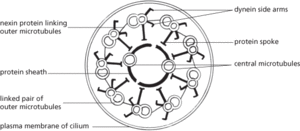1. (in prokaryotes) A long slender structure that protrudes from the cell surface of a bacterium. It rotates from its base and propels the bacterium along. Up to several micrometres in length, a flagellum is constructed of numerous subunits of the protein flagellin, while at the base a system of rings anchors the flagellum in the cell wall and plasma membrane. Surrounding these rings are paired motor proteins, which impart a rotary motion to the filament, and switch proteins, which can reverse the direction of rotation. Flagella may be attached singly or in groups, for example at the poles of the bacterial cell, or scattered over the cell surface.
2. (in eukaryotes) (undulipodium) A slender flexible outgrowth of a eukaryote cell used for locomotion or propelling fluids over the surface of the cell. Many protists and sperm cells swim by means of flagella, and various organisms use them to establish feeding currents or to clear debris from epithelial surfaces. All flagella (and cilia) have a shaft, about 0.25 μm in diameter, consisting of a longitudinal array of microtubules, the axoneme, which is surrounded by an extension of the cell’s plasma membrane. The axoneme has two singlet microtubules running down the middle and nine doublet microtubules around the periphery, giving a characteristic 9+2 array. At its base the axoneme connects with a basal body (or kinetosome). This is a short cylinder that, like a centriole, consists of nine triplet microtubules; it organizes assembly of the axoneme microtubules and is part of a complex array of fibres and microtubules forming a root structure within the cell. Cilia are typically 1–10 µm long and move by a whiplike power stroke followed by a recovery stroke in the opposite direction. Flagella can be 100–200 µm long and generate successive waves that pass from the base to the tail. In both cases, flexing of the shaft is produced by a sliding motion of the microtubule doublets relative to each other. This involves the successive formation and breakage of molecular bridges between adjacent doublets. The bridges are composed of a protein, dynein, and their formation requires energy in the form of ATP. See tinsel flagellum.

Cross section of a eukaryotic flagellum
- Karelian orogeny
- Karginsky
- KARI
- Karle, Isabella Helen
- Karle, Jerome
- Karl G. Jansky Very Large Array
- karma
- Karmarkar’s algorithm
- Karnak
- Karnaugh map
- Karnian
- karre
- karren
- Karrer, Paul
- karst
- karstic aquifer
- karyogamy
- karyogram
- karyokinesis
- karyolysis
- karyoplasm
- karyorrhexis
- karyotype
- Kasavubu, Joseph (1910–69)
- Kashirskian